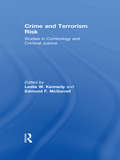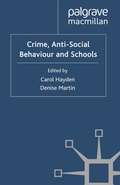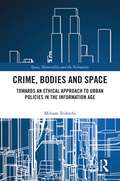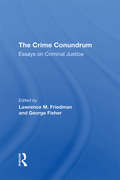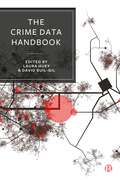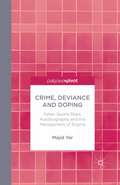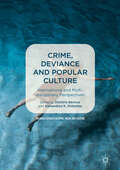- Table View
- List View
Crime And Society In Britain (PDF)
by Hazell CroallThis book looks at how crimes are defined, socially constructed, researched and analyzed. Exploring the relationship between crime and social equality, the text applies these insights to specific patterns of crime.
Crime and Society in Twentieth-Century England (PDF)
by Clive EmsleyCrime and Society in Twentieth-Century England traces the broad pattern of criminal offending over a hundred year period that experienced unprecedented levels of upheaval and change. This period included two world wars, the end of the British Empire, significant shifts in both gender relations and ethnic mix and a decline in the power of the economy. In this new textbook, Professor Clive Emsley provides an up-to-date assessment of changes in attitudes to crime as well as of the developments in policing, in the courts and in penal sanctions over the course of the century. He explores the impact of growing gender equality and ethnic diversity on crime and criminal justice, and looks at the way in which crime became increasingly central to political agendas in the last third of the century. Written in a clear and accessible manner, the book examines: Perceptions of crime and criminality across the century Varieties of offending from murder to benefit fraud The role of the media in constructing and reinforcing the understanding of crime and the criminal The decline and demise of corporal and capital punishment The shift from largely progressive to more punitive penal practice The first serious attempt to explore the history of crime and criminal justice in twentieth-century England, this book will be an invaluable introduction to the student and interested general reader alike.
Crime and Terrorism Risk: Studies in Criminology and Criminal Justice
by Leslie W. Kennedy Edmund F. McGarrellCrime and Terrorism Risk is a collection of original essays and articles that presents a broad overview of the issues related to the assessment and management of risk in the new security age. These original articles show how researchers, experts and the public are beginning to think about crime and terrorism issues in terms of a new risk paradigm that emphasizes establishing a balance between threat and resources in developing prevention and response strategies.
Crime and Terrorism Risk: Studies in Criminology and Criminal Justice
by Leslie W. Kennedy Edmund F. McGarrellCrime and Terrorism Risk is a collection of original essays and articles that presents a broad overview of the issues related to the assessment and management of risk in the new security age. These original articles show how researchers, experts and the public are beginning to think about crime and terrorism issues in terms of a new risk paradigm that emphasizes establishing a balance between threat and resources in developing prevention and response strategies.
Crime and the City: Essays in Memory of John Barron Mays
by David DownesThese essays reflect the stress on the local, urban, social world conveyed by John Mays as essential for an understanding of crime and delinquency. It was Mays' work which opened up what has since become familiar territory: delinquency in its place, neighbourhood and social setting.
Crime and the Construction of Forensic Objectivity from 1850: Space, Media, Experts And Ethics (Palgrave Histories of Policing, Punishment and Justice)
by Alison AdamThis book charts the historical development of 'forensic objectivity' through an analysis of the ways in which objective knowledge of crimes, crime scenes, crime materials and criminals is achieved. Taking an interdisciplinary approach, with authors drawn from law, history, sociology and science and technology studies, this work shows how forensic objectivity is constructed through detailed crime history case studies, mainly in relation to murder, set in Scotland, England, Germany, Sweden, USA and Ireland. Starting from the mid-nineteenth century and continuing to the present day, the book argues that a number of developments were crucial. These include: the beginning of crime photography, the use of diagrams and models specially constructed for the courtroom so jurors could be ‘virtual witnesses’, probabilistic models of certainty, the professionalization of medical and scientific expert witnesses and their networks, ways of measuring, recording and developing criminal records and the role of the media, particularly newspapers in reporting on crime, criminals and legal proceedings and their part in the shaping of public opinion on crime. This essential title demonstrates the ways in which forensic objectivity has become a central concept in relation to criminal justice over a period spanning 170 years.
Crime and the Imaginary of Disaster: Post-Apocalyptic Fictions and the Crisis of Social Order
by M. YarThis study explores the 'imaginary of disaster' that appears in popular fictions about the apocalyptic breakdown of society. Focusing on representations of crime, law, violence, vengeance and justice, it argues that an exploration post-apocalyptic story-telling offer us valuable insights into social anxieties.
Crime, Anti-Social Behaviour and Schools
by Carol Hayden and Denise MartinThe behaviour and safety of children and young people in and around schools is a topic of world-wide concern. From school shootings and deaths on school premises to the everyday behaviour of young people in school, this book explores what is happening in schools in Britain and links it with evidence from elsewhere in the world.
Crime, Bodies and Space: Towards an Ethical Approach to Urban Policies in the Information Age
by Miriam TedeschiWith cities increasingly following rigid rules for designing out crime and producing spaces under surveillance, this book asks how information shapes bodies, space, and, ultimately, policymaking. In recent years, public spaces have changed in Western countries, with the urban realm becoming an ever-more monitored, privatised, homogeneous, and aseptic space that has lost its character, uniqueness, and diversity in the name of ‘security’. This underpins precise moral and political choices in terms of what a space should be, how it can be used, and by whom. These choices generate material consequences concerning urban inequality and freedom, or otherwise, of movement. Based on ethnographic and autoethnographic explorations in London’s ‘criminal’ spaces, this book illustrates how rules, policies, and moral values, far from being abstract concepts, are in fact material. Outlining the basis of a new urban information ethics, the book both exposes and challenges how moral values and predefined categories are applied to, and materially shape, the movement of bodies in urban space with regard to crime and security policies. Drawing on Gilbert Simondon’s information theory and a wide range of work in urban studies, geography, and planning, as well as in surveillance studies, object-oriented ontology, and contemporary theoretical work on both materiality and affect, the book provides a radically new perspective on urban space in general, and crime and security in particular. This book uses a balanced mix of theoretical concepts and empirical study to bring theory and practice together in an intertwining of ethnography and autoethnography.This book will be of interest to students and scholars in the fields of urban studies, urban geography, sociology, surveillance studies, legal theory, socio-legal studies, planning law, environmental law, and land law.
Crime, Bodies and Space: Towards an Ethical Approach to Urban Policies in the Information Age
by Miriam TedeschiWith cities increasingly following rigid rules for designing out crime and producing spaces under surveillance, this book asks how information shapes bodies, space, and, ultimately, policymaking. In recent years, public spaces have changed in Western countries, with the urban realm becoming an ever-more monitored, privatised, homogeneous, and aseptic space that has lost its character, uniqueness, and diversity in the name of ‘security’. This underpins precise moral and political choices in terms of what a space should be, how it can be used, and by whom. These choices generate material consequences concerning urban inequality and freedom, or otherwise, of movement. Based on ethnographic and autoethnographic explorations in London’s ‘criminal’ spaces, this book illustrates how rules, policies, and moral values, far from being abstract concepts, are in fact material. Outlining the basis of a new urban information ethics, the book both exposes and challenges how moral values and predefined categories are applied to, and materially shape, the movement of bodies in urban space with regard to crime and security policies. Drawing on Gilbert Simondon’s information theory and a wide range of work in urban studies, geography, and planning, as well as in surveillance studies, object-oriented ontology, and contemporary theoretical work on both materiality and affect, the book provides a radically new perspective on urban space in general, and crime and security in particular. This book uses a balanced mix of theoretical concepts and empirical study to bring theory and practice together in an intertwining of ethnography and autoethnography.This book will be of interest to students and scholars in the fields of urban studies, urban geography, sociology, surveillance studies, legal theory, socio-legal studies, planning law, environmental law, and land law.
Crime, Community and Locale: The Northern Ireland Communities Crime Survey
by David O'Mahony Ray Geary Kieran McEvoy John MorisonThis title was first published in 2000: This text reports on the findings of the Communities Crime Survey, a communities-based survey carried out within Northern Ireland. The survey asked a number of questions beyond the usual remit of local crime surveys, in order to explore more fully a whole range of issues relating to the experience of living in a society where more obvious manifestations of conflict are beginning to recede and other more mundane but still important issues relating to crime and policing are coming to the fore. The book aims to go behind the headlines of violence and political conflict to examine how people in a range of communities in Northern Ireland experience a whole range of factors relating to crime, policing and the general experience of living within their particular communities. The process of change is far from over in Northern Ireland, and this book indicates how some of the central issues that must be resolved are perceived by a range of ordinary people in various urban and rural communities, in religiously segregated and integrated communities and those with different levels of income and social infrastructure. The experiences and attitudes gathered are important in understanding how the process of change and development in this society might be advanced, and what lessons might be offered to elsewhere. The survey ultimately concludes that Northern Ireland is neither a homogeneous entity nor a society that is simply divided on religious and/or political grounds. Rather it is a society that is divided by religion and politics, but also by a number of other variables, including geography, gender, age, socio-economic class and ethnic origin, all of which in part influence people's experiences and attitudes towards crime and policing.
Crime, Community and Locale: The Northern Ireland Communities Crime Survey
by David O'Mahony Ray Geary Kieran McEvoy John MorisonThis title was first published in 2000: This text reports on the findings of the Communities Crime Survey, a communities-based survey carried out within Northern Ireland. The survey asked a number of questions beyond the usual remit of local crime surveys, in order to explore more fully a whole range of issues relating to the experience of living in a society where more obvious manifestations of conflict are beginning to recede and other more mundane but still important issues relating to crime and policing are coming to the fore. The book aims to go behind the headlines of violence and political conflict to examine how people in a range of communities in Northern Ireland experience a whole range of factors relating to crime, policing and the general experience of living within their particular communities. The process of change is far from over in Northern Ireland, and this book indicates how some of the central issues that must be resolved are perceived by a range of ordinary people in various urban and rural communities, in religiously segregated and integrated communities and those with different levels of income and social infrastructure. The experiences and attitudes gathered are important in understanding how the process of change and development in this society might be advanced, and what lessons might be offered to elsewhere. The survey ultimately concludes that Northern Ireland is neither a homogeneous entity nor a society that is simply divided on religious and/or political grounds. Rather it is a society that is divided by religion and politics, but also by a number of other variables, including geography, gender, age, socio-economic class and ethnic origin, all of which in part influence people's experiences and attitudes towards crime and policing.
Crime Control: The Use and Misuse of Police Resources (Criminal Justice and Public Safety)
by David John FarmerThe question of how to use police resources productively, par ticularly in this era of tight municipal budgets, is a major con cern for police chiefs and others responsible for crime control. In Crime Control: The Use and Misuse of Police Resources, David J. Farmer provides new insights into this question and sug gests a practical resource allocation approach for police poli cymakers and administrators. The book documents the results of current police resource allocation practices and describes the major research studies that have identified a need to restructure police field operations. It very usefully outlines the development and nature of allocation techniques and ana lyzes the political contexts which influence resource alloca,., tion. After describing planning at the neighborhood level that should inform the allocation process, the author provides a comprehensive "planning-budgeting-resources allocation" approach to managing a productive police department. This comprehensive approach is illustrated by an account of the Manpower Allocation Review System (MARS), which the author developed and introduced in the New York City Police Department in 1972 when I was commissioner. As I can vii FOREWORD viii attest, the MARS approach had practical utility. For the author, it served as a forerunner to the more elaborate system he describes in this book.
The Crime Conundrum: Essays On Criminal Justice
by Lawrence M. Friedman George FisherThere may be areas of human life in which people have profited from understanding history, but criminal justice is definitely not one of them. In this field, each generation seems to undo the last generation's reforms. Each generation resurrects old failures and trots them out as new. A previous generation hailed indeterminate sentencing as a great
The Crime Conundrum: Essays On Criminal Justice
by Lawrence M. Friedman George FisherThere may be areas of human life in which people have profited from understanding history, but criminal justice is definitely not one of them. In this field, each generation seems to undo the last generation's reforms. Each generation resurrects old failures and trots them out as new. A previous generation hailed indeterminate sentencing as a great
Crime, Criminal Justice and Religion: A Critical Appraisal (Routledge Studies in Crime and Society)
by Philip Birch Conor Murray Andrew McInnesCrime, Criminal Justice and Religion: A Critical Appraisal seeks to bridge a gap in the examination of crime and criminal justice by taking both a historical and a contemporary lens to explore the influence of religion. Offering unique perspectives that consider the impact on modern-day policy and practice, the book scrutinises a range of issues such as abortion, hate crime and desistance as well as reflecting upon the influence religion can have on criminal justice professions. The book acts to renew the importance of, and recognise, the influence and impact religion has in terms of how we view and ultimately address crime and deliver criminal justice. One of the first books to cover the area of crime, criminal justice and religion, the book is split into three parts, with part 1 - 'Contextualising Crime, Criminal Justice and Religion' - providing an introduction to crime, criminal justice and religion, and reflections on the role religion has had, and continues to have, in how crime is understood and how we respond to it. Part 2 - 'Appraisal of Institutions and Professional Practice' - considers the issue of religion through institutions and professions of criminal justice, such as the police and legal profession, while part 3 - 'Appraisal of Contemporary Issues' - explores a range of crime and criminal justice issues in on which religion has had an impact, such as the death penalty and terrorism. Crime, Criminal Justice and Religion will be of primary interest to academics, researchers and students in criminology, law, sociology, psychology, social policy and related Humanities, Arts and Social Sciences disciplines. It will also be of interest to theologians, both as scholars and practitioners. The book is a body of work that will appeal at an international level and will also be a key resource for a range of practitioners across the globe working on issues concerning crime and criminal justice.
Crime, Criminal Justice and Religion: A Critical Appraisal (Routledge Studies in Crime and Society)
by Philip Birch Conor Murray Andrew McInnesCrime, Criminal Justice and Religion: A Critical Appraisal seeks to bridge a gap in the examination of crime and criminal justice by taking both a historical and a contemporary lens to explore the influence of religion. Offering unique perspectives that consider the impact on modern-day policy and practice, the book scrutinises a range of issues such as abortion, hate crime and desistance as well as reflecting upon the influence religion can have on criminal justice professions. The book acts to renew the importance of, and recognise, the influence and impact religion has in terms of how we view and ultimately address crime and deliver criminal justice. One of the first books to cover the area of crime, criminal justice and religion, the book is split into three parts, with part 1 - 'Contextualising Crime, Criminal Justice and Religion' - providing an introduction to crime, criminal justice and religion, and reflections on the role religion has had, and continues to have, in how crime is understood and how we respond to it. Part 2 - 'Appraisal of Institutions and Professional Practice' - considers the issue of religion through institutions and professions of criminal justice, such as the police and legal profession, while part 3 - 'Appraisal of Contemporary Issues' - explores a range of crime and criminal justice issues in on which religion has had an impact, such as the death penalty and terrorism. Crime, Criminal Justice and Religion will be of primary interest to academics, researchers and students in criminology, law, sociology, psychology, social policy and related Humanities, Arts and Social Sciences disciplines. It will also be of interest to theologians, both as scholars and practitioners. The book is a body of work that will appeal at an international level and will also be a key resource for a range of practitioners across the globe working on issues concerning crime and criminal justice.
Crime, Criminalization and Refugees: The Case of Sudanese Australians (SpringerBriefs in Criminology)
by Darren Palmer Garry Coventry Glenn Dawes Stephen MostonThis book explores criminal justice responses to Sudanese Australians, crime and victimization. Based on research in four major Queensland communities, it adopts a multi-faceted approach to capture the ‘voices’ of various interest groups. Challenging the concept that Sudanese Australian refugees are the criminal ‘other’ that primary definers such as the media or would have us believe, it also highlights the differently situated subgroups of Sudanese Australians with a focus on how individuals and groups develop and maintain a sense of belonging: not always successful and not always law abiding but by no means indicative of the reductive notion of the criminogenic refugee.
The Crime Data Handbook
by Ian Brunton-Smith Tim Verlaan Henk Elffers Sam Langton Stuart Thomas Sophie Curtis-Ham Sarah Czarnomski Lisa Tompson Jesús C. Aguerri Fernando Miró-Llinares Kirsty Bennett Tomas Diviak Craig Bennell Tori Semple Bryce Jenkins Jack Cunliffe Angelo Moretti Jose Pina-Sanchez Thiago R. Oliveira Leticia Couto Marta Murrià Sangenís Cristina Sobrino Garcés Timothy I. Cubitt Mark Mills Nico Trajtenberg Olga Sanchez de Ribera de Castro Carly Lighttowlers Lucy Bryant Olivia Horsefield Francisco J. Castro-Toledo Ana B. Gómez-Bellvís Scott Keay Jude Towers Sara Correia-Hopkins José María López Riba Raquel Bartolomé Gutiérrez Esther Fernández-Molina Rosemary Barberet Anthony Morgan Alexandru Cernat Alex Sutherland Nicholas LordCrime research has grown substantially over the past decade, with a rise in evidence-informed approaches to criminal justice, statistics-driven decision-making and predictive analytics. The fuel that has driven this growth is data – and one of its most pressing challenges is the lack of research on the use and interpretation of data sources. This accessible, engaging book closes that gap for researchers, practitioners and students. International researchers and crime analysts discuss the strengths, perils and opportunities of the data sources and tools now available and their best use in informing sound public policy and criminal justice practice.
The Crime Data Handbook
by Ian Brunton-Smith Tim Verlaan Henk Elffers Sam Langton Stuart Thomas Sophie Curtis-Ham Sarah Czarnomski Lisa Tompson Jesús C. Aguerri Fernando Miró-Llinares Kirsty Bennett Tomas Diviak Craig Bennell Tori Semple Bryce Jenkins Jack Cunliffe Angelo Moretti Jose Pina-Sanchez Thiago R. Oliveira Leticia Couto Marta Murrià Sangenís Cristina Sobrino Garcés Timothy I. Cubitt Mark Mills Nico Trajtenberg Olga Sanchez de Ribera de Castro Carly Lighttowlers Lucy Bryant Olivia Horsefield Francisco J. Castro-Toledo Ana B. Gómez-Bellvís Scott Keay Jude Towers Sara Correia-Hopkins José María López Riba Raquel Bartolomé Gutiérrez Esther Fernández-Molina Rosemary Barberet Anthony Morgan Alexandru Cernat Alex Sutherland Nicholas LordCrime research has grown substantially over the past decade, with a rise in evidence-informed approaches to criminal justice, statistics-driven decision-making and predictive analytics. The fuel that has driven this growth is data – and one of its most pressing challenges is the lack of research on the use and interpretation of data sources. This accessible, engaging book closes that gap for researchers, practitioners and students. International researchers and crime analysts discuss the strengths, perils and opportunities of the data sources and tools now available and their best use in informing sound public policy and criminal justice practice.
Crime, Deviance and Doping: Fallen Sports Stars, Autobiography and the Management of Stigma
by M. YarYar examines the autobiographies of fallen sports stars, exploring their fall from grace and the stigma it entails. Drawing upon sociological and criminological perspectives, it illuminates how fallen stars use confessional acts of story-telling to seek forgiveness, vindication and redemption.
Crime, Deviance and Popular Culture: International and Multidisciplinary Perspectives (Palgrave Studies in Crime, Media and Culture)
by Alexandros K. Antoniou Dimitris AkrivosThis book explores the links between crime, deviance and popular culture in our highly-mediatised era, offering an insight into the cultural processes through which particular practices acquire a criminal or deviant status, and come to be seen as social problems. Adopting a multidisciplinary approach, the edited collection brings together international scholars across various areas of specialisation to provide an up-to-date analysis of some important and topical issues in 21st-century popular culture. The chapters look at different aspects of popular culture, including fictional detective narratives and the true crime genre, popular media constructions of sexual deviance and Islamophobia, sports, graffiti and outlaw biker subcultures. The authors examine a wide range of relevant case studies through a number of crime and deviance-related theories. Crime, Deviance and Popular Culture will be of importance to scholars and students across several disciplines, including criminology, sociology of deviance, social anthropology, media studies, cultural studies, television studies and linguistics.
Crime, Disorder and Symbolic Violence: Governing the Urban Periphery
by M. BowdenThis timely book provides a theoretical and empirical engagement with contemporary understandings of the governance of crime, safety and security. Using a Bourdieuian framework, Bowden explores concepts such as capital, habitus and symbolic power to present an analytic tool-kit for a critically engaged public criminology.
Crime, Drugs and Social Theory: A Phenomenological Approach
by Chris AllenDo criminal cultures generate drug use? Crime, Drugs and Social Theory critiques conventional academic and policy thinking concerning the relationship between urban deprivation, crime and drug use. Chris Allen outlines an innovative constructionist phenomenological perspective to explore these relationships in a new light. He discusses how people living in deprived urban areas develop ’natural attitudes’ towards activities, such as crime and drug use, that are prevalent in the social worlds they inhabit, and shows that this produces forms of articulation such as ’I don’t know why I take drugs’, ’I just take them’ and ’drugs come naturally to me’. He then draws on his constructionist phenomenology to help understand the ’natural attitude’ towards crime and drugs that emerge from conditions of urban deprivation, as well as the non-reasoned forms of articulation that emerge from this attitude. The book argues that understanding the conditions in which drug users deviate from their ’natural attitude’ can help effective intervention in the lives of drug users.
Crime, Drugs and Social Theory: A Phenomenological Approach
by Chris AllenDo criminal cultures generate drug use? Crime, Drugs and Social Theory critiques conventional academic and policy thinking concerning the relationship between urban deprivation, crime and drug use. Chris Allen outlines an innovative constructionist phenomenological perspective to explore these relationships in a new light. He discusses how people living in deprived urban areas develop ’natural attitudes’ towards activities, such as crime and drug use, that are prevalent in the social worlds they inhabit, and shows that this produces forms of articulation such as ’I don’t know why I take drugs’, ’I just take them’ and ’drugs come naturally to me’. He then draws on his constructionist phenomenology to help understand the ’natural attitude’ towards crime and drugs that emerge from conditions of urban deprivation, as well as the non-reasoned forms of articulation that emerge from this attitude. The book argues that understanding the conditions in which drug users deviate from their ’natural attitude’ can help effective intervention in the lives of drug users.


